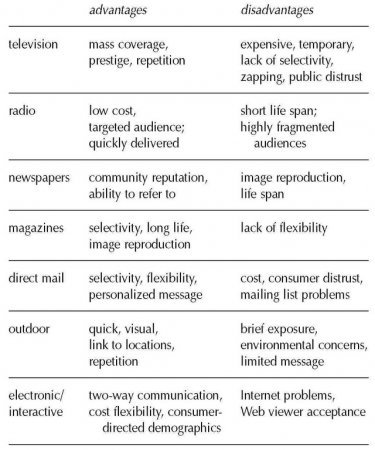Advertising
Advertising - communication of a product or service through various media - is distinguished from publicity in that it is paid for and from personal selling in that it is nonpersonal and directed toward a group of consumers, the firm’s target market. While many people think advertising and personal selling are essentially all there is to marketing, advertising is part of an organization’s integrated marketing communications. Integrated marketing communications is the coordination of all promotional efforts, including advertising, direct mail, personal selling, sales promotion, and public relations. An organization’s integrated marketing communications are, in turn, part of the organization’s marketing strategy, including pricing, distribution, and product strategies as well as marketing communications.
Advertising in the United States began in the 18th century with craftsmen placing signs outside their dwellings to symbolize their trade. Cobblers used a shoe, gunsmiths used a rifle, and seamstresses used scissors to convey to consumers what product or service they offered. Especially in a market where many consumers were illiterate, symbols told consumers what was available. Even today these symbols can still be seen in company logos and small-town businesses. (Twentieth-century restaurateurs also used pictures of meal combinations to assist illiterate consumers.) Before billboard advertising, firms hired individuals to carry sandwich boards along city streets telling consumers about their products. Early print advertisements included newspaper ads and flyers distributed in markets.
Advertisements typically promote either products or institutions. Product advertisements promote particular products or services, while institutional advertisements promote ideas; concepts; philosophies; or the goodwill of an industry, firm, or organization. Advertising is used by both for-profit and nonprofit organizations. Major media are required to provide outlets for community-service advertising.
Generally there are three goals in advertising: to inform, persuade, or remind consumers and potential customers. Modern advertisements may consist of a billboard announcing a new business located nearby (inform), a television advertisement trying to convince diners to eat at a particular fast-food restaurant (persuade), or a postcard from the dentist to say a tooth cleaning is due (remind).
One variation of persuasive advertising is comparative advertising: efforts that directly or indirectly promote comparisons with competing products. Companies that are not the dominant firm in the industry often favor this form of advertising, comparing their products to the offerings of the leading firm in the industry. Avis car rentals was one of the early users of comparative advertising with their “We’re #2, We Try Harder” campaign. Federal Trade Commission regulations require advertisers to be able to substantiate claims made in comparative advertisements.
Few consumers realize how much effort and planning goes into advertising campaigns. Marketers start by defining objectives for an advertising effort. target markets are identified, advertising messages and media determined, and the new advertising campaign coordinated with other elements in the organization’s marketing strategy.
Often considerable research is used in making advertising decisions. Consumer opinions and reactions are tested, and product features, market conditions, and competitors are all analyzed before executing an advertising campaign. Creative aspects of advertising—including wording, symbols, colors, and use of celebrities—are all carefully analyzed. Focus groups are often asked to comment on advertising design before the campaign is implemented.
Print advertisements typically contain four elements: the headline, illustration, body copy, and signature. The headline is a catchy word or phrase designed to gain attention. The illustration or images combine with the headline to gain interest as well as attention. The body copy serves to inform and then persuade consumers into taking action. The signature includes the company’s name, address, and/or trademark to remind viewers who is sponsoring the advertisement.
Once advertising objectives are defined, tactical plans are developed, including budgets, media choices, and scheduling. Each step is critical to the success of an advertising campaign. A good message conveyed through the right media but at the wrong time will likely fail. For example, Campbell Soup Company once coordinated a radio campaign in the Northeast, scheduling messages with weather reports. The first message said, “Storms are coming, time to stock up on Campbell Soup.” When storms arrived, the follow-up message said, “It’s cold outside, time to stay warm with a cup of Campbell Soup.” The same message delivered in the summertime would have failed.
There are seven media alternatives advertisers can use to convey their message to their target audience: television, radio, newspapers, magazines, direct mail, outdoor, and electronic/interactive. Each media alternative has advantages and disadvantages:
As portrayed on many television shows, most major advertisers hire advertising agencies to plan and prepare advertising campaigns (automobile manufacturers, the military, and beer companies are the largest spenders in the United States). Advertising agencies live and die with decisions by major clients to take their account to another agency. In today’s global marketplace, ad agencies have emerged to become international service providers for their clients.
See also Advertising industry
Further reading
Boone, Louis E., and David L. Kurtz. Contemporary Marketing, 10th ed. Fort Worth, Tex.: Dryden Press, 2001.
